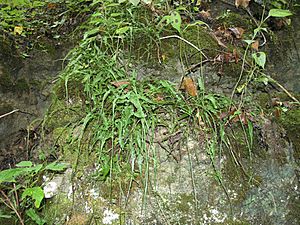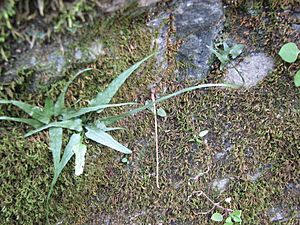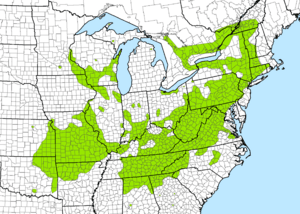Walking fern facts for kids
Asplenium rhizophyllum, also known as the walking fern, is a common plant found in North America. It's a type of fern. This fern has a special way of growing new plants, which gives it its unique name. It's related to another "walking fern" found in East Asia.
Quick facts for kids Walking fern |
|
|---|---|
 |
|
| Asplenium rhizophyllum on rocks in the Red River Gorge, Daniel Boone National Forest, Kentucky, USA. | |
| Conservation status | |
| Scientific classification | |
| Genus: |
Asplenium
|
| Species: |
rhizophyllum
|
| Synonyms | |
|
Antigramma rhizophylla (L.) J.Sm. |
|
Contents
What Does the Walking Fern Look Like?
The walking fern is a small plant. It has special evergreen leaves that stay green all year. These leaves are not divided like many other ferns. They have long, narrow tips that often curve and can even grow roots! This gives the fern a very unique look.
Walking ferns usually grow in clumps. You might see smaller "child" plants growing around them. These new plants come from the tips of the parent plant's leaves. Younger ferns often have leaves that lie flat on the ground. Older ferns have leaves that stand up or arch over.
Underground Parts: Roots and Rhizomes
This fern doesn't spread by its roots. Instead, it uses rhizomes. Rhizomes are like underground stems. They grow straight up or nearly straight. They are short and thin, about 1 millimeter (0.04 inches) wide.
These rhizomes have dark brown or black scales. These scales are shaped like narrow triangles. They are about 2 to 3 millimeters (0.08 to 0.12 inches) long.
Leaves: The Walking Part
The leaf stalk, called the stipe, is usually 0.5 to 12 centimeters (0.2 to 4.7 inches) long. Sometimes it can be up to 15 centimeters (5.9 inches) long. The stipe is reddish-brown and shiny at the bottom. It turns green higher up. Small scales are found at the base of the stipe.
The leaf blades are not divided into smaller parts. They are narrow and can be different shapes, even on the same plant. They are 1 to 30 centimeters (0.4 to 11.8 inches) long and 0.5 to 5 centimeters (0.2 to 2 inches) wide. The leaves feel a bit leathery. They have a few hairs, especially on the underside.
The most amazing part is the leaf tips! They are usually very long and pointy. When these tips touch the ground, they can grow roots and start a brand new plant. This is how the fern "walks" across the ground over time. Sometimes, even the small rounded parts at the base of the leaf can grow roots.
Spores and Reproduction
Underneath the fertile leaves, you'll find many small clusters called sori. These sori are 1 to 4 millimeters (0.04 to 0.16 inches) long. They are not arranged in any special order. Each sorus is covered by a thin, white layer called an indusium. Each tiny sporangium inside a sorus holds 64 spores.
Ferns That Look Similar
The walking fern's unique leaf shape and its ability to grow new plants from its tips make it easy to spot.
- The Asian walking fern (A. ruprechtii) also has long, growing tips. But its leaves are wider in the middle and get narrower at the base.
- The hart's-tongue fern (A. scolopendrium) has larger, shinier leaves with rounded tips.
How the Walking Fern Got Its Name
This fern is commonly called the North American walking fern or just walking fern. This is because new plants grow from the leaf tips. This allows the fern to "walk" across surfaces over many years. The scientific name "rhizophyllum" also means "root leaf," which describes this special feature.
The famous scientist Carl Linnaeus first named this fern Asplenium rhizophyllum in 1753. For a while, some scientists thought it should be in a different group called Camptosorus. This was because of how its spore clusters were arranged. However, modern studies show that Camptosorus ferns actually belong within the Asplenium group.
Where Does the Walking Fern Live?
The walking fern is mostly found in the Appalachian Mountains and the Ozarks in North America. You can find it from southern Quebec and Ontario in Canada, all the way down to Mississippi and Alabama in the United States. It also grows along the Ohio Valley and into the Ozarks, reaching west to Nebraska and Oklahoma. It can also be found along the Mississippi Valley, north to Wisconsin and Minnesota.
It used to grow in Maine and Delaware but is no longer found there. While some say it's rare, it's actually very common in places where the conditions are just right for it to grow.
Where It Grows and How It's Protected
Walking ferns like to grow on shaded rocks, ledges, and in cracks. They are usually covered with moss. Sometimes, you might find them on fallen tree trunks or even on the ground. They almost always grow on limestone or other rocks that are alkaline (not acidic). Rarely, they are found on sandstone or acidic rocks.
Even though it's common overall, the walking fern is in danger in some states and provinces. For example, it is considered very rare in Mississippi, New Hampshire, and Rhode Island. It is also somewhat rare in Michigan and South Carolina.
Growing Walking Ferns at Home
The walking fern was first grown in gardens in England in 1680. If you want to grow one, it likes low to medium light. It also prefers moist soil that is basic (alkaline). You can add lime chips to the soil to make it more alkaline.




